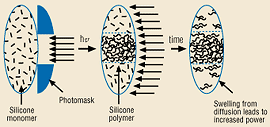Laser Adjustable Lens: a new generation in implants
A toric IOL has been developed that can be adjusted non-invasively with a laser postoperatively.
NEW ORLEANS — The rationale for an adjustable toric IOL is that IOL power is often not exactly right after surgery. Patients tend to have 0.5 D to 1 D of residual myopia, hyperopia or cylinder. This limits patient satisfaction. Researchers’ goals were to create a foldable toric lens from photosensitive silicone that could be fine tuned postoperatively by treating with a laser to alter the radius of the curvature.
“The goal of the research project was to develop a toric IOL that can be adjusted non-invasively with a laser,” Robert K. Maloney, MD, said during a presentation at the New Orleans Academy of Ophthalmology. “The idea was to make this from a photosensitive silicone so that the material would absorb the light and adjust its power by changing its radius of curvature.
“Physicians are trying to measure axial length more accurately, but there are always going to be refractive errors after cataract surgery,” he said. Additionally, cataract surgeons cannot be sure exactly what the anterior chamber depth will be after cataract surgery. Also, it is impossible to determine where astigmatism will settle, so currently there is no fundamental way to get an accurate prediction ahead of time for lens power.
Retinal specialist Daniel M. Schwartz, MD, from the University of California San Francisco, developed the Laser Adjustable Lens implant in collaboration with Caltech investigators Jagdish Jethmalani, PhD; Chris Sandstedt, PhD; Robert Grubbs, PhD; and Julie Kornfield, PhD. Calhoun Vision Inc. of Pasadena, Calif., owns the lens.
Theory of power adjustment
THEORY OF POWER ADJUSTMENT 
The foldable Laser Adjustable Lens is made of silicone that is not completely polymerized. Silicone monomers are embedded in silicone lens matrix and attached to photosensitizing molecules. The laser polymerizes the silicone monomers in a selective region. The area of the lens that is polymerized thickens as the remaining monomers diffuse into the lasered area.
“You radiate the center of the lens to polymerize the silicone monomers that are remaining in the center,” Dr. Maloney said. “Then there is a diffusion gradient, and you have unpolymerized monomers in high concentrations in some areas and low concentrations of monomers in others.”
The monomer diffuses down the concentration gradient into the center of the lens. This makes the lens thicker, increasing the lens power and thus correcting the residual refractive error. For hyperopia, laser power would be aimed at the center of the lens, while for myopia correction, the laser would be aimed on the periphery. Astigmatism may be corrected by lasering a band across the lens, he explained.
According to Dr. Maloney, the procedure is non-invasive, and he compares it to a YAG treatment. A lens can be lasered after the refraction has stabilized.
“Our goal is to make every cataract patient a refractive surgery patient, and thereby make every cataract surgeon a refractive surgeon,” Dr. Maloney said. “Medicare will pay for the lens implant, and the patient will pay for the adjustment. This frees cataract surgeons from total dependence on Medicare for their reimbursement, since the adjustment is a refractive procedure.”
Preclinical studies
To date, the Laser Adjustable Lens is still in preclinical trials with clinical trials expected to begin in early 2001, Dr. Maloney said. The lens has been implanted in rabbit models to prove compatibility. After 6 months, no inflammation has been reported.
Preclinical studies have demonstrated that a 5 D power adjustment is achievable with this lens and the material is stable, with no leaching. Additionally, studies have shown that indoor lighting does not cause the lens to polymerize.
For Your Information:
- Robert K. Maloney, MD, can be reached at 10921 Wilshire Blvd., Ste. 900, Los Angeles, CA 90024; (310) 208-3937; fax: (310) 208-8058; e-mail: drmaloney@maloneyvision.com. Dr. Maloney has a direct financial interest in the Laser Adjustable Lens. He is a paid consultant for Calhoun Vision Inc.
- Daniel M. Schwartz, MD, can be reached at University of California San Francisco, Box 0730, 10 Kirkham St., San Francisco, CA 94143; (415) 476-1887; fax: (415) 476-0336. Dr. Schwartz is chairman of Calhoun Vision Inc.
